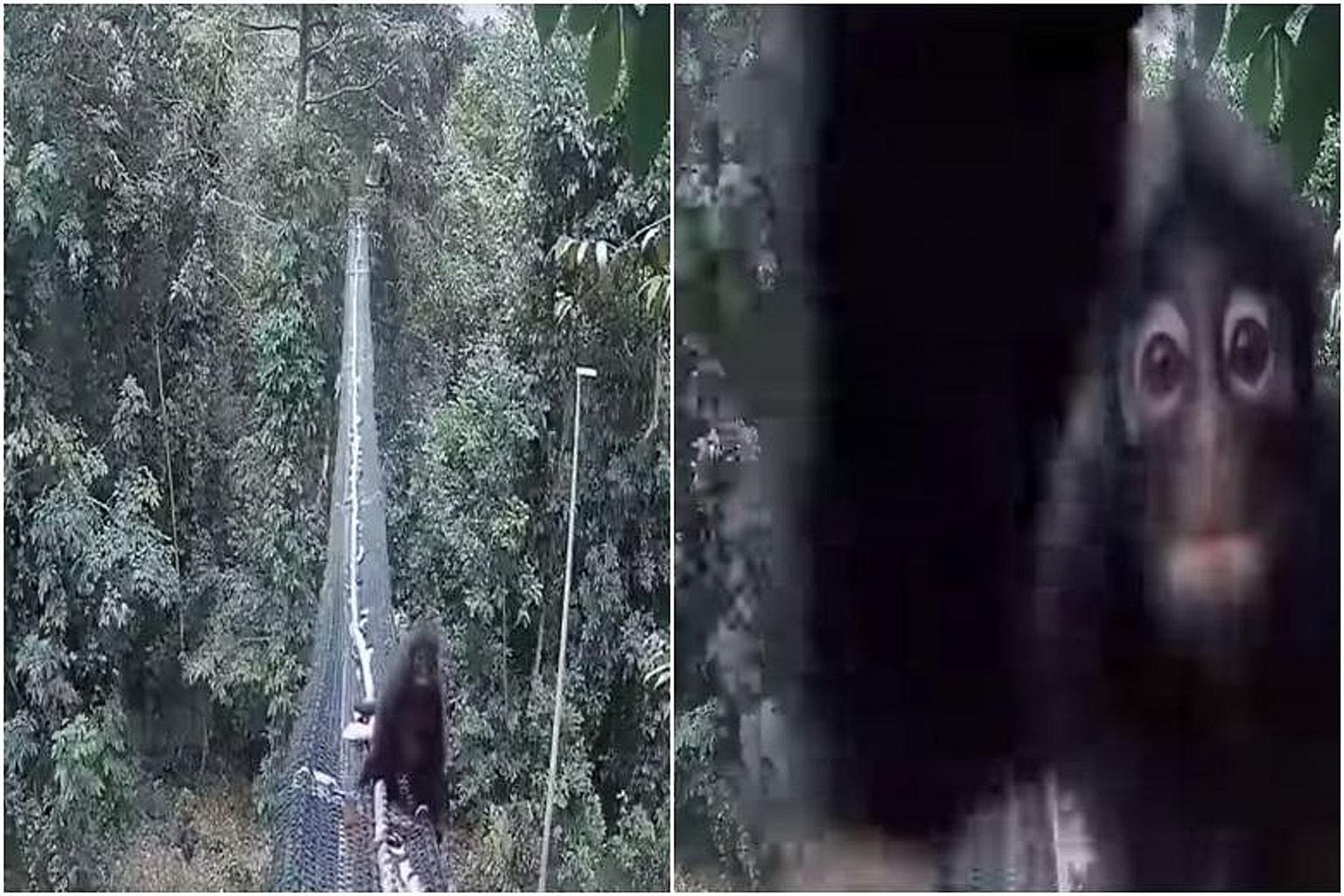Endangered monkeys seen using rope bridge to cross road
Sighting in Old Upper Thomson Road gives hope that Raffles' banded langurs will thrive
Sign up now: Get ST's newsletters delivered to your inbox

Screengrabs showing a Raffles' banded langur using the rope ladder bridge to cross from Thomson Nature Park to the forests of the Central Catchment Nature Reserve.
PHOTO: DESMOND LEE/ FACEBOOK
Follow topic:
Motorists driving along Old Upper Thomson Road may not have noticed a rope bridge overhead.
Built by the National Parks Board (NParks) last August, it is to help animals cross from the Thomson Nature Park to the forests of the Central Catchment Nature Reserve.
A new video showing three critically endangered Raffles' banded langurs using the bridge has excited conservationists.
Posted online by NParks last Thursday, the video shows the shy, black-and-white monkeys using the bridge to cross the dual-lane road. As they make their way from one end to the other, a car drives by under them.
Found only in a cluster of forests in the Central Catchment Nature Reserve and a number of surrounding buffer forests, the langur is one of two monkey species in Singapore. The other is the brown-furred long-tailed macaque, which is more commonly seen.
Dr Adrian Loo, NParks' group director for conservation, said langurs have been spotted using the rope ladder bridge on multiple occasions, with the most recent sighting on April 6.
Primate scientist Andie Ang, who is with the Wildlife Reserves Singapore (WRS) Conservation Fund, said the sighting was significant as it showed that the arboreal bridge was useful in allowing wildlife to cross safely. The connectivity was crucial for the species as it could expand the forested areas the langurs could access to find food and mates, she added.
There are only 63 Raffles' banded langurs left in Singapore.
Earlier research by Dr Ang and five other scientists from National University of Singapore and Andalas University in Indonesia showed that the genetic make-up of this species - which can also be found in southern Peninsular Malaysia - was distinct enough for it to be considered a species in its own right. There are two other langur species in the region.
Second Minister for National Development Desmond Lee shared the video in a Facebook post last Thursday and said Thomson Nature Park is a key conservation site for Singapore's rare native biodiversity, including the langur.
"The habitats and ecological connectivity of the area had been enhanced for the langurs," he said. "Rope bridges between the nature park and the adjacent Central Catchment Nature Reserve act as canopy linkages to keep them safe from traffic."
Thomson Nature Park is home to about three troops of langurs, including one comprising five bachelors, said Dr Ang. Previously, the langurs had used the natural canopy of the trees on both sides of Old Upper Thomson Road to cross.
But tree pruning in 2017 disrupted this connectivity, she noted.
"After that, volunteers saw the langurs descending to the ground to make the crossing. But unlike macaques, langurs are arboreal animals and are uncomfortable travelling on the ground," she said.
It took consistent monitoring over the years by Dr Ang and Ms Sabrina Jabbar, a WRS Conservation Fund project assistant, as well as volunteers who joined a citizen science survey, to narrow down the location along the 3km-long Old Upper Thomson Road that the langurs were most likely to use again.
"Based on the observations, we recommended the location for the bridge to NParks," said Dr Ang, who chairs the Raffles' banded langur working group comprising representatives from NParks, WRS, the Nature Society (Singapore) as well as volunteers.
She said more rope bridges or other artificial crossing aids could be used to facilitate the movement of wildlife in Singapore's fragmented forest landscape, adding, however, that "such devices should not be seen as an alternative to preserving habitat and maintaining natural canopy connectivity".
NParks' Dr Loo said the board will be installing more rope ladder bridges to enhance connectivity for arboreal animals. He added: "A second rope ladder bridge had been installed earlier this year across Old Upper Thomson Road at a spot in the canopy that is frequented by the langurs. This complements the original rope ladder bridge that was installed last year."
Dr Loo also said NParks will continue to work with the Raffles' banded langur working group to identify new crossing sites.

